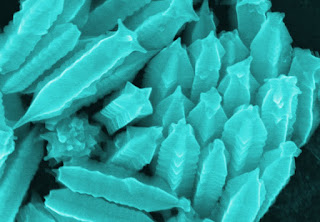Starfruit-shaped gold nanorods synthesized by chemist Eugene Zubarev and Leonid Vigderman, a graduate student in his lab at Rice’s BioScience Research Collaborative, could nourish applications that rely on surface-enhanced Raman spectroscopy (SERS).
The research appeared online this month in the American Chemical Society journal Langmuir.
The researchers found their particles returned signals 25 times stronger than similar nanorods with smooth surfaces. That may ultimately make it possible to detect very small amounts of such organic molecules as DNA and biomarkers, found in bodily fluids, for particular diseases.
“There’s a great deal of interest in sensing applications,†said Zubarev, an associate professor of chemistry. “SERS takes advantage of the ability of gold to enhance electromagnetic fields locally. Fields will concentrate at specific defects, like the sharp edges of our nanostarfruits, and that could help detect the presence of organic molecules at very low concentration.â€
SERS can detect organic molecules by themselves, but the presence of a gold surface greatly enhances the effect, Zubarev said. “If we take the spectrum of organic molecules in solution and compare it to when they are adsorbed on a gold particle, the difference can be millions of times,†he said. The potential to further boost that stronger signal by a factor of 25 is significant, he said.

Nanostarfruits begin as gold nanowires with pentagonal cross-sections. Rice chemist Eugene Zubarev believes silver ions and bromide combine to form an insoluble salt that retards particle growth along the pentagons’ flat surfaces. Photo courtesy Zubarev Lab / Rice University.

Gold nanoparticles created by the Rice University lab of Eugene Zubarev take on the shape of starfruit in a chemical bath with silver nitrate, ascorbic acid and gold chloride. Photo courtesy Zubarev Lab/Rice UniversityZubarev and Vigderman grew batches of the star-shaped rods in a chemical bath. They started with seed particles of highly purified gold nanorods with pentagonal cross-sections developed by Zubarev’s lab in 2008 and added them to a mixture of silver nitrate, ascorbic acid and gold chloride.
Over 24 hours, the particles plumped up to 550 nanometers long and 55 nanometers wide, many with pointy ends. The particles take on ridges along their lengths; photographed tip-down with an electron microscope, they look like stacks of star-shaped pillows.
Why the pentagons turn into stars is still a bit of a mystery, Zubarev said, but he was willing to speculate. “For a long time, our group has been interested in size amplification of particles,†he said. “Just add gold chloride and a reducing agent to gold nanoparticles, and they become large enough to be seen with an optical microscope. But in the presence of silver nitrate and bromide ions, things happen differently.â€
When Zubarev and Vigderman added a common surfactant, cetyltrimethylammonium bromide (aka CTAB), to the mix, the bromide combined with the silver ions to produce an insoluble salt. “We believe a thin film of silver bromide forms on the side faces of rods and partially blocks them,†Zubarev said.
This in turn slowed down the deposition of gold on those flat surfaces and allowed the nanorods to gather more gold at the pentagon’s points, where they grew into the ridges that gave the rods their star-like cross-section. “Silver bromide is likely to block flat surfaces more efficiently than sharp edges between them,†he said.
The researchers tried replacing silver with other metal ions such as copper, mercury, iron and nickel. All produced relatively smooth nanorods. “Unlike silver, none of these four metals form insoluble bromides, and that may explain why the amplification is highly uniform and leads to particles with smooth surfaces,†he said.
The researchers also grew longer nanowires that, along with their optical advantages, may have unique electronic properties. Ongoing experiments with Stephan Link, an assistant professor of chemistry and chemical and biomolecular engineering, will help characterize the starfruit nanowires’ ability to transmit a plasmonic signal. That could be useful for waveguides and other optoelectronic devices.
But the primary area of interest in Zubarev’s lab is biological. “If we can modify the surface roughness such that biological molecules of interest will adsorb selectively on the surface of our rugged nanorods, then we can start looking at very low concentrations of DNA or cancer biomarkers. There are many cancers where the diagnostics depend on the lowest concentration of the biomarker that can be detected.â€
The National Science Foundation and Welch Foundation supported the research.
-30- +sookie tex
Contact: David Ruth david@rice.edu 713-348-6327 Rice University Mike Williams 713-348-6728 mikewilliams@rice.edu
